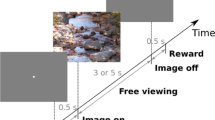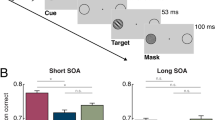Abstract
Selective attention to color or motion enhances activity in specialized areas of extrastriate cortex, but mechanisms of attentional modulation remain unclear. By dissociating modulation of visually evoked transient activity from the baseline for a particular attentional set, human functional neuroimaging was used to investigate the physiological basis of such effects. Baseline activity in motion- and color-sensitive areas of extrastriate cortex was enhanced by selective attention to these attributes, even without moving or colored stimuli. Further, visually evoked responses increased along with baseline activity. These results are consistent with the hypothesis that attention modulates sensitivity of neuronal populations to inputs by changing background activity.
This is a preview of subscription content, access via your institution
Access options
Subscribe to this journal
Receive 12 print issues and online access
$209.00 per year
only $17.42 per issue
Buy this article
- Purchase on Springer Link
- Instant access to full article PDF
Prices may be subject to local taxes which are calculated during checkout



Similar content being viewed by others
References
Chawla, D., Phillips, J., Buechel, C., Edwards, R. & Friston, K. J. Speed-dependent motion-sensitive responses in V5: An fMRI study. Neuroimage 7, 86–96 (1998).
Tootell, R. B. et al. Functional analysis of human MT and related visual cortical areas using magnetic resonance imaging. J. Neurosci. 15, 3215–3230 (1995).
Watson, J. D. et al. Area V5 of the human brain: evidence from a combined study using positron emission tomography and magnetic resonance imaging. Cereb. Cortex 3, 79–94 (1993).
Zeki, S. et al. A direct demonstration of functional specialization in human visual cortex. J. Neurosci. 11, 641–649 (1991).
Livingstone, M. S. & Hubel, D. H. Segregation of form, color, movement and depth: anatomy physiology and perception. Science 240, 740–749 (1988).
Dubner, R. & Zeki, S. M. Response properties and receptive fields of cells in an anatomically defined region of the superior temporal sulcus in the monkey. Brain Res. 35, 528–532 (1971).
Luck, S. J., Chelazzi, L., Hillyard, S. A. & Desimone, R. Neural mechanisms of spatial selective attention in areas V1, V2, and V4 of macaque visual cortex. J. Neurophysiol. 77, 24–42 (1997).
Ferrera, V. P., Rudolph, K. K. & Maunsell, J. H. Responses of neurons in the parietal and temporal visual pathways during a motion task. J. Neurosci. 14, 6171–6186 (1994).
Treue, S. & Maunsell, J. H. Attentional modulation of visual motion processing in cortical areas MT and MST. Nature 382, 539–541 (1996) .
Corbetta, M., Miezin, F. M., Dobmeyer, S., Shulman, G. L. & Petersen, S. E. Selective and divided attention during visual discriminations of shape, color and speed: functional anatomy by positron emission tomography. J. Neurosci. 11, 2383–2402 (1991).
Buechel, C. et al. The functional anatomy of attention to visual motion: A functional MRI study. Brain 121, 1281–1294 (1998).
O'Craven, K. M., Rosen, B. R., Kwong, K. K., Treisman, A. & Savoy, R. L. Voluntary attention modulates fMRI activity in human MT-MST. Neuron 18, 591–598 (1997).
Haenny, P. E. & Schiller, P. H. State dependent activity in monkey visual cortex. I. Single cell activity in V1 and V4 on visual tasks. Exp. Brain Res. 69, 225–244 (1988).
Spitzer, H., Desimone, R. & Moran, J. Increased attention enhances both behavioral and neuronal performance. Science 240, 338–340 (1988).
Rees, G., Frackowiak, R. & Frith, C. D. Two modulatory effects of attention that mediate object categorization in human cortex. Science 275, 835–838 (1997).
Chawla, D., Lumer, E. D. & Friston, K. J. Relating macroscopic measures of brain activity to fast dynamic neuronal interactions. Neural Comput. (in press).
Josephs, O., Turner, R. & Friston K. J. Event-related fMRI. Hum. Brain Map. 5, 243–248 (1997).
Buckner, R. L. et al. Detection of cortical activation during averaged single trials of a cognitive task using functional magnetic resonance imaging. Proc. Natl. Acad. Sci. USA 93, 14878–14883 (1996).
Tootell, R. B. et al. Functional analysis of V3a and related areas in human visual cortex. J. Neurosci. 17, 7060–7078 (1997).
Chawla, D., Lumer, E. D. & Friston, K. J. The relationship between synchronization among neuronal populations and their mean activity levels. Neural Comput. 11, 1389–1411 (1999).
Mangun, G. R. in Cognitive Electrophysiology (eds. Heinze, H. J., Munte, T. F. & Mangun, G. R.) 1–101 (Birkhauser, Boston, 1994).
Morecraft, R. J., Geula, C. & Mesulam, M. M. Architecture of connectivity within a cingulo-fronto-parietal neurocognitive network for directed attention. Arch. Neurol. 50, 279–284 (1993).
Mesulam, M. M. A cortical network for directed attention and unilateral neglect. Ann. Neurol. 10, 309–325 (1981).
Friston, K. J., Josephs, O., Rees, G. & Turner, R. Nonlinear event-related responses in fMRI. Magn. Reson. Med. 39, 41–52 (1998).
Friston, K. J. et al. The spatial registration and normalisation of images. Hum. Brain Map. 3, 165–189 (1996).
Talairach, J. & Tournoux, P. Coplanar Stereotaxic Atlas of the Human Brain (Thieme, New York, 1988).
Acknowledgements
We thank the radiographers at the Wellcome Department of Cognitive Neurology for their help. This work was supported by the Wellcome Trust.
Author information
Authors and Affiliations
Corresponding author
Rights and permissions
About this article
Cite this article
Chawla, D., Rees, G. & Friston, K. The physiological basis of attentional modulation in extrastriate visual areas. Nat Neurosci 2, 671–676 (1999). https://doi.org/10.1038/10230
Received:
Accepted:
Issue Date:
DOI: https://doi.org/10.1038/10230
This article is cited by
-
Preparatory attention to visual features primarily relies on non-sensory representation
Scientific Reports (2022)
-
The human endogenous attentional control network includes a ventro-temporal cortical node
Nature Communications (2021)
-
Effects of a Brief Mindfulness-Based Attentional Intervention on Threat-Related Perceptual Decision-Making
Mindfulness (2021)
-
Object responses are highly malleable, rather than invariant, with changes in object appearance
Scientific Reports (2020)
-
Neuronal baseline shifts underlying boundary setting during free recall
Nature Communications (2017)



